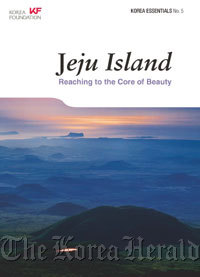
Jeju Island: Reaching to the Core of Beauty
(Seoul Selection)
Located off the southernmost coast of Korea, Jeju Island houses both beauty and rich culture.
For international readers who’d like to learn more about the island, “Jeju Island: Reaching to the Core of Beauty,” jointly published by Seoul Selection and Korea Foundation, would be a great source of information and joy.
The book is far from a tour guide. It begins with a brief introduction by Jean-Marie Gustave Le Clezio, one of the most acclaimed living French authors and the 2008 Nobel Prize winner. The writer lived in Korea for a year, teaching French and literature at Ewha Womans University from 2007-08.
“There is a certain melancholy about the island,” Le Clezio writes. “We don’t know where it comes from, but the feeling holds you. Perhaps it’s the wind, and the grayish green tint that impregnates everything, the rocks, the tree trunks, the springs and even the sea. On Jeju, that feeling is even stronger than usual.”
Complimented with some spectacular photos of scenic Jeju, the book dedicates its first two chapters to Jeju’s nature. It introduces some of the famous spots on the island, including UNESCO-designated Majang Cave, Mount Halla, and Gotjawal ― a forest on Jeju that grows out of the rocky terrain.
The third chapter of the book is titled “Island of Women.” The chapter follows the lives of Jeju “Haenyo,” or diving women, and its female shamans who are famous for Jeju’s Yeongdeung ritual. The book manages to describe the women’s distinctive qualities ― “open and artless, courageous and resilient” ― paired with Jeju’s nature and culture, as well as their inevitable influence. “Gods and rituals are part of everyday life for the women of Jeju, who must spend their lives on the boundary of life and death in the water,” the book says. “… These characteristics of the female islanders are rooted in the fact that Jeju is an island.” Hilty also introduces Kim Man-deok (1739-1812) Jeju’s first female merchant during the Joseon Dynasty.
The book also provides a great overview on Jeju history in the fourth chapter, including a series of events that took place there during the Japanese occupation (1910-1945) and the April 3 Jeju Uprising in 1948. The book also offers a page introducing some simple phrases in Jeju dialect, including “Nalbopseo, issuka?” meaning “Hello, Are you there?” and “Honjeoopseoye” meaning “Welcome!”
“Jeju Island: Reaching to the Core of Beauty” has been compiled, edited and supplemented by American scholar Anne Hilty, from various Jeju-themed articles by local writers published in the past issues of Koreana -- a quarterly magazine on Korean culture and arts published by Korea Foundation.
This book is the fifth in a series titled “Korea Essentials,” a cooperative project between the Korea Foundation and Seoul Selection to engage more international readers in Korean arts and culture. The English-language series previously featured Hangeul, the Korean alphabet, traditional Korean paintings, Korean cuisine and the DMZ.
(dyc@heraldcorp.com)
-
Articles by Korea Herald




















